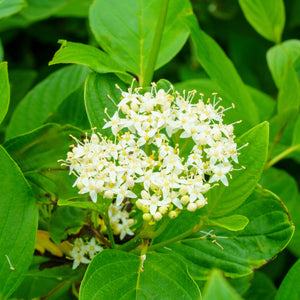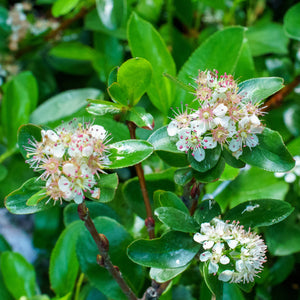The Chokeberry Guide

About
Chokeberry belongs to the Rosaceae family and includes two primary species commonly grown in landscapes: Aronia melanocarpa (Black Chokeberry) and Aronia arbutifolia (Red Chokeberry). These shrubs are admired for their compact form, attractive blooms, and ability to thrive in poor or wet soils.
Popular varieties include Aronia melanocarpa 'Autumn Magic', known for its compact habit and deep purple-black berries, and Aronia arbutifolia 'Brilliantissima', which offers brilliant red fall foliage and bright red fruit. Newer cultivars like Aronia melanocarpa 'UCONNAM165' (Ground Hog™) and 'UCONNAM166' (Low Scape Hedger™) offer improved form and utility in modern landscapes, from low hedges to erosion control.
Besides their ornamental appeal, chokeberries are edible and rich in antioxidants, often used in jams, juices, and health supplements. Their adaptability, tolerance to pests and diseases, and wildlife benefits make them a reliable and attractive shrub across a range of uses.
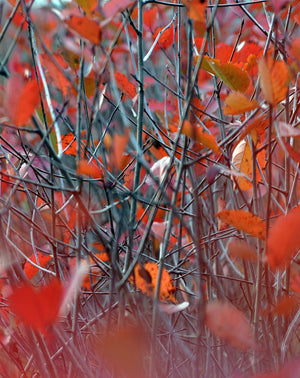
PLANTING
Chokeberries are versatile shrubs that adapt well to many sites, but proper planting ensures the healthiest growth and best ornamental display.
- USDA Hardiness Zones: Most varieties thrive in Zones 3–8, tolerating cold winters and warm summers.
- Soil: Prefers moist, well-drained, slightly acidic soils but will tolerate wet or dry conditions once established. Chokeberries grow well in clay, loam, or sandy soils.
- Sunlight: Performs best in full sun for optimal flowering and berry production, but tolerates partial shade.
- Watering: Water regularly during the first year to establish roots. Mature plants are drought-tolerant but appreciate supplemental watering during prolonged dry periods.
- Spacing: Plant 3–6 feet apart depending on variety and desired spread. Compact cultivars like 'Low Scape Hedger™' may be planted more closely for hedge effect.
- Planting Time: Best planted in early spring or fall when soil is cool and moist.
To plant, dig a hole twice as wide as the root ball and just as deep. Place the shrub in the hole, backfill with native soil, and water thoroughly. Apply mulch around the base to retain moisture and suppress weeds.
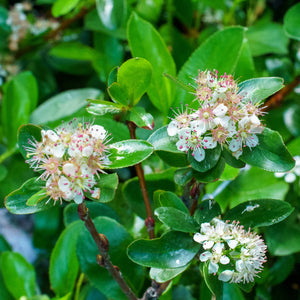
CARE
Chokeberries require minimal maintenance once established, making them an excellent choice for low-input landscapes.
- Watering: Keep the soil consistently moist during establishment, then water only during extended dry periods.
- Fertilizing: Typically not needed in fertile soils. If desired, apply a balanced, slow-release fertilizer in early spring.
- Pruning: Prune in late winter or early spring to remove dead wood and encourage new growth. Suckers may be removed to maintain a tidy shape or left for a more natural, thicket-like form.
- Pests & Diseases: Chokeberries are resistant to most pests and diseases. Occasional leaf spot or powdery mildew may appear but rarely affect plant health.

HOW TO USE
Chokeberries are incredibly versatile in the landscape and offer multi-season appeal. Their attractive foliage, flower clusters, and showy berries can be used to enhance both naturalistic and formal designs.
- Hedges and Screens: Use upright cultivars like Aronia arbutifolia 'Brilliantissima' or Aronia melanocarpa 'Autumn Magic' to form low privacy hedges.
- Mass Plantings: Compact types like 'Low Scape Hedger™' and 'Ground Hog™' are ideal for massing on slopes or along walkways.
- Rain Gardens: Tolerant of wet conditions, chokeberry thrives in stormwater retention areas and low spots.
- Pollinator and Wildlife Gardens: Spring flowers attract bees, while berries feed birds and other wildlife in fall and winter.
- Mixed Borders: Pair with other seasonal standouts like Itea virginica, Clethra alnifolia, or Hydrangea arborescens for layered interest.
With its bold fall color and persistent berries, chokeberry also works well as a seasonal focal point in compact landscapes.
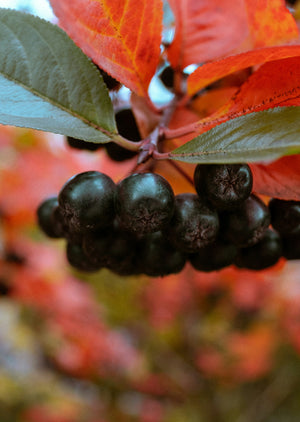
Common Questions
- How do you plant chokeberry? Choose a sunny to partly shaded site with well-drained soil. Dig a hole twice as wide as the root ball, place the shrub, backfill, water thoroughly, and mulch.
- Is chokeberry toxic to dogs or cats? While the berries are high in antioxidants and considered safe for human consumption, large quantities may cause mild gastrointestinal upset in pets.
- Do deer eat chokeberry? Chokeberry is considered moderately deer-resistant. Deer may nibble new growth but usually leave established shrubs alone.
- Do rabbits eat chokeberry? Rabbits may browse young shoots, especially in winter. Use protective barriers if damage is a concern.
- How do you prune chokeberry? Prune in late winter or early spring to remove dead or damaged branches. Thinning cuts can improve shape and air circulation. Suckers can be controlled or allowed to naturalize.
Conclusion
Chokeberry offers four-season beauty, environmental benefits, and edible fruit all in one resilient shrub. Whether used as a wildlife attractor, slope stabilizer, or seasonal accent, Aronia fits seamlessly into many landscape designs. With cultivars ranging from compact groundcovers to upright hedges, it’s easy to find a variety that suits your space and style.

